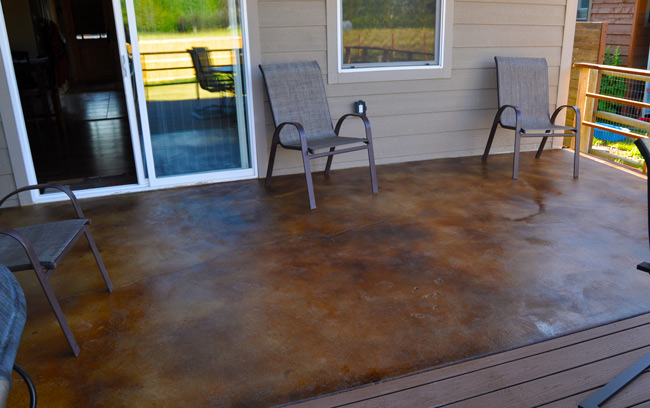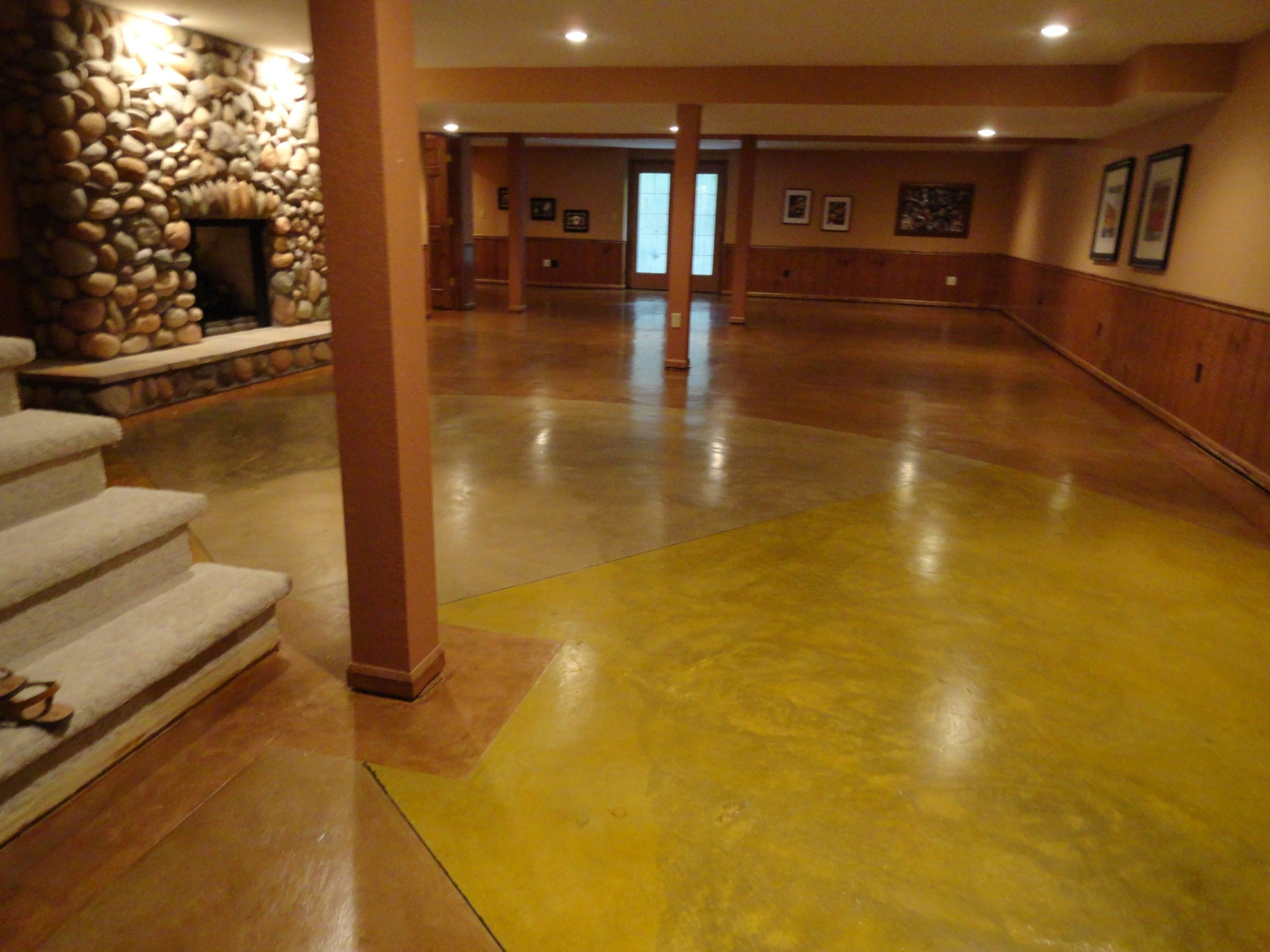Recognizing the Various Kinds of Stained Concrete for Your Next Project
Stained concrete offers different alternatives that deal with different visual and useful requirements. Each kind presents distinctive qualities that influence the last appearance and resilience of the surface. Comprehending these distinctions is essential for any person planning a task. From abundant, chain reactions of acid-based stains to the lively harmony of solid color stains, the choices can greatly influence the result. What aspects should one think about when picking the perfect tarnish for their details demands?
Introduction of Stained Concrete
Stained concrete offers as a flexible flooring choice that can boost the aesthetic charm of various spaces. This strategy involves applying a coloring agent to the surface area of existing concrete, enabling for a wide range of layout opportunities. Stained concrete is prominent in both property and industrial settings, providing a sturdy and low-maintenance solution that can mimic the appearance of all-natural materials like rock or tile.
The staining procedure can be carried out using water-based or solvent-based products, each offering distinctive visual effects. The final appearance is influenced by aspects such as the original concrete surface area, the kind of stain utilized, and the application technique. Stained concrete not only enhances exterior and interiors yet likewise promotes sustainability by rejuvenating existing concrete frameworks. Therefore, it has actually acquired traction amongst property owners and developers seeking both capability and design in their floor covering selections.
Acid-Based Stains: Qualities and Benefits

Unique Color Variations
Concrete surface areas can transform dramatically with the application of acid-based stains, which supply an abundant scheme of one-of-a-kind shade variants. These stains pass through the concrete, responding chemically to create vivid earth tones that range from deep browns and reds to soft greens and blues. The resulting shades are typically variegated, producing a natural, marble-like appearance that enhances the concrete's personality. Each application returns distinctive results because of variants in the concrete's composition and the staining method made use of, making every project one-of-a-kind. Furthermore, acid-based stains can be layered or combined with various other methods to produce personalized designs, enabling for individual expression. This convenience makes acid-based stains a prominent choice for both residential and business applications.
Chemical Reactions Discussed
While numerous elements add to the efficiency of acid-based stains, the underlying chemical responses play a crucial role in their one-of-a-kind attributes and benefits. These stains mostly consist of water, acid, and metal salts. When used to concrete, the acid reacts with the calcium hydroxide in the cement, developing a chemical improvement that leads to permanent shade adjustments. The metallic salts penetrate the surface area and bond with the concrete, enabling a large range of colors and tones. This response not just enhances aesthetic appeal yet also supplies durability, making the color resistant to fading and wear. Additionally, acid-based stains can develop a variegated surface that resembles all-natural stone, further enhancing their appeal for decorative concrete applications.
Surface Area Preparation Relevance
Achieving suitable results with acid-based stains rests on complete surface area prep work. This important action warranties that the concrete surface is clean, devoid of contaminants, and appropriately profiled for excellent discolor absorption. Any type of existing sealants, dust, or oils can impede the chemical reaction that creates the desired shade and finish, resulting in uneven or patchy results.
Prior to applying the tarnish, the concrete should be mechanically cleaned or stress cleaned, adhered to by a thorough examination for cracks or flaws that might need fixing. Additionally, validating the surface is appropriately dried out will certainly enhance stain adherence. By prioritizing these preparatory measures, the long life and vibrancy of acid-based stains can be significantly boosted, resulting in a more aesthetically pleasing and long lasting coating.
Water-Based Stains: Attributes and Benefits

Water-based stains pass through the concrete, using a more clear surface that highlights the natural appearance and variations of the surface underneath. They are readily available in a broad array of colors, permitting for imaginative adaptability in style. In addition, water-based stains are much easier to cleanse up, requiring just water and soap, which simplifies the application process.
Their fast drying time boosts efficiency, making them a useful selection for both do it yourself lovers and experts. On the whole, water-based stains offer an attractive mix of aesthetic versatility and straightforward properties, making them a prominent option for concrete enhancement tasks.
Strong Shade Stains: Lively Options for a Strong Appearance
Strong shade stains supply an efficient option for those looking for to develop a strong and vibrant aesthetic on concrete surface areas. These stains provide a consistent coloration that can dramatically enhance the visual charm of floorings, patios, and driveways. Offered in a vast range of shades, strong color stains permit imaginative expression, dealing with different design choices.
One of the key advantages of strong shade stains is their capability to hide imperfections, supplying a fresh and refined want to aging concrete - Stained Concrete Floors Austin. Furthermore, their formula generally consists of UV-resistant properties, making certain longevity and shade retention even in rough weather
Application is simple, needing minimal prep work of the concrete surface. Once used, solid shade stains can be secured for included defense and sheen, additional elevating their aesthetic top quality. With their vivid choices, strong color stains are a superb option for those going for an see this impactful and cohesive design.
Semi-Transparent Stains: Achieving Depth and Dimension
Semi-transparent stains offer a distinct strategy to improving concrete surfaces by supplying depth and measurement through different shade options. Recognizing the application techniques is vital for accomplishing the preferred result, while proper upkeep practices ensure durability. This area will certainly explore these vital elements to maximize the benefits of semi-transparent staining.
Shade Options Available
A variety of color alternatives exists for semi-transparent stains, allowing property owners and developers to improve the natural beauty of concrete surface areas. These stains are available in a variety of tones, from earthy tones like browns and terracottas to vibrant shades such as blues and eco-friendlies. The semi-transparent nature of these stains enables the underlying concrete to show through, creating a distinct deepness and measurement that can match various layout aesthetic appeals. Additionally, combining different shades can generate custom-made tones, allowing a tailored seek each job. This adaptability makes semi-transparent stains a popular option for both interior and outside applications, as they can harmonize with surrounding aspects while including aesthetic rate of interest to plain concrete.
Application Methods Explained
To attain the wanted depth and measurement with semi-transparent stains, proper application techniques are vital. Initially, surface preparation is crucial; see page the concrete needs to be tidy and cost-free of any type of contaminants. This usually involves power washing and fixing any kind of splits. Next, picking the appropriate applicator, such as a sprayer, roller, or brush, can affect the last look. Sprayers permit a much more even application, while rollers can assist accomplish structure. It is essential to use the stain in thin, also coats, permitting each layer to dry before including an additional. Manipulating the application strategy, such as differing pressure or using various devices, can develop distinct effects. Ultimately, sealing the stained surface boosts the vibrancy of the shades while providing defense.
Upkeep Ideal Practices
Regular upkeep is crucial for maintaining the elegance and integrity of surface areas treated with semi-transparent stains. To keep these surfaces, regular cleaning is essential. Using a pH-neutral cleaner and a soft-bristle mop will aid remove dirt and particles without damaging the tarnish. It is suggested to stay clear of extreme chemicals, as they can break down the tarnish's look. Additionally, periodic resealing every one to three years can secure against wear and fading. This procedure entails cleansing the surface area thoroughly and applying a compatible sealer created for stained concrete. Homeowners should likewise keep track of for any type of signs of staining or useful site damage and address these problems immediately to ensure durable vibrancy and durability. Adhering to these best practices will improve the overall lifespan of semi-transparent stained surface areas.
Results and Strategies: Customizing Your Stained Concrete
Personalizing stained concrete includes an array of strategies that enhance both aesthetics and functionality. Amongst these techniques, layering various discolor shades can develop depth and complexity, permitting for distinct visual impacts. Methods such as acid discoloration give a variegated appearance, while water-based stains supply a more consistent look.
Additionally, incorporating ornamental patterns, such as stenciling or inscription, can even more personalize the surface, adding detailed designs that provide to individual preferences. Texturing the concrete, whether via stamping or mop finishes, introduces tactile elements that not just enhance hold however likewise improve visual passion.
Furthermore, using sealers can enhance the color vibrancy and supply security versus wear. Modification strategies extend past simple color; they can change a conventional concrete slab right into a spectacular centerpiece, making it appropriate for both property and commercial areas. With careful option of results and methods, stained concrete can attain an absolutely tailored look.
Maintenance and Long Life of Stained Surfaces
Although stained concrete surfaces are understood for their sturdiness and visual charm, preserving their integrity is crucial for ensuring longevity. Routine cleaning is important; sweeping and wiping with a pH-neutral cleaner assists protect against dust accumulation and staining. Additionally, using a sealant every couple of years can safeguard the surface from dampness, chemicals, and UV damage, thereby improving its life expectancy.
It is also vital to attend to any splits or chips immediately. Tiny fixings can reduce further wear and tear, maintaining the visual and structural top quality of the surface. For outdoor stained concrete, seasonal maintenance, such as getting rid of snow and ice, is required to stop surface damages from freeze-thaw cycles.
Often Asked Concerns
Can I Stain Existing Concrete Surfaces or New Ones?
The inquiry of whether existing concrete surfaces can be stained emerges regularly. It is without a doubt feasible to stain both new and old concrete, supplied the surface area is appropriately prepared and without contaminants for ideal attachment.
Exactly how Long Does the Discoloration Process Typically Take?
The staining procedure usually takes one to three days, depending on elements such as surface prep work, sort of discolor, and climate conditions. Austin Stained Concrete Floors. Treating time might expand past preliminary application, affecting the general duration significantly
Is Stained Concrete Safe for Outdoor Use?
Stained concrete is normally secure for outdoor usage, offered it is appropriately sealed. This securing protects against wetness and UV damage, making sure toughness and security, while also enhancing the aesthetic allure of exterior areas.
Can I Use Multiple Spot Layers for Different Effects?
Applying several discolor layers can attain diverse impacts on stained concrete. It is necessary to guarantee compatibility between stains and permit proper drying time between applications to stay clear of unintentional reactions or discoloration.
Are There Any Type Of Shade Limitations for Stained Concrete?
Shade restrictions for stained concrete primarily depend on the kind of discolor made use of, with water-based stains using a more comprehensive palette contrasted to acid-based stains. Stained Concrete Floors Austin. Accomplishing lively shades might require mindful selection and application strategies.